Pre-Calculus 11 Student Edition Chapter 2 Trigonometry
Page 114 Problem 1 Answer
The objective of the problem is to draw △ABC
with a given length of sides:
a=3 cm
b=4 cm
c=5 cm
The required triangle with given side lengths can be done with a ruler as shown below:
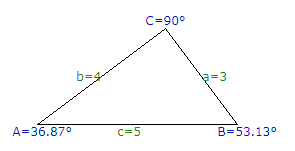
Hence, the required triangle with given side values can be shown below:
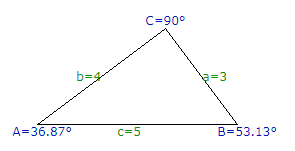
Page 114 Problem 2 Answer
The values of a2,b2, and c2.
The given values of a=3,b=4, and c=5
The value of
a2=(3)2=9
b2=(4)2=16
c2=(5)2=25
The values are :
a2=9,b2=16,c2=25
Precalculus Textbook Mcgraw Hill Answers
Page 114 Problem 3 Answer
On comparing the values of a2,b2,c2.
The values are :a2=9,b2=16,c2=25.
The value of −a2=−9
The relation is true when −9+16<25.
Hence, the relation is true when a2+b2 <c2.
The relation is true when −a2+b2<c2.
Read and Learn More Precalculus Textbook Mcgraw Hill Answers
Page 114 Problem 4 Answer
The measure of ∠C.
Using Pythagorean Theorem, a2+b2=c2
Here, the given values are a=3,b=4,c=5
This triangle follows the Pythagorean triplet rule,
c2=a2+b2
52=32+42
It is a right-angled triangle at C.
So, ∠C=90˚
The value of ∠C=90˚.
Page 114 Problem 5 Answer
Draw an acute ΔABC, Acute angle is less than 90∘
So we make a triangle with all the angles less than 90∘
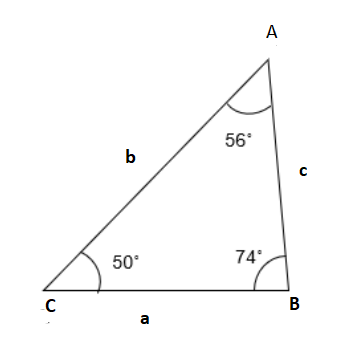
For example , we can make a triangle with angle ∠A=56∘and angle∠B=74∘and angle ∠C=50∘
All angles are less than 90∘.
Acute triangle ABC
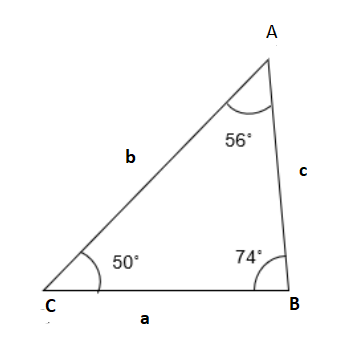
Page 114 Problem 6 Answer
From part (a) we got the acute triangle ABC
Make the base that is length of a= 5 cm. Using protractor measure the angle and connect all the vertices.
Now measure the length of b and c
Length of b=5.8 and c=4.6
Length of sides of triangle ABC
Precalculus Textbook Mcgraw Hill Answers
a=5 cm
b= 5.8 cm
c=4.6 cm
Page 114 Problem 7 Answer
Given: a=5,b=5.8,c=4.6
To find: a2,b2,c2
a2=5×5=25
b2=5.8×5.8=33.64
c2=4.6×4.6=21.16
a2=25,b2=33.64,c2=21.16
Page 114 Problem 8 Answer
Given: a2=25,b2=33.64,c2=21.26
To compare: a2+b2and c2
a2+b2=25+33.64=58.64
So: a2+b2>c2 is true.
We do not get the other statement true after calculations.
a2+b2>c2 is true.
Page 115 Problem 9 Answer
Given: a2+b2=25,c2=25
To find: 2abcosC=a2+b2−c2
2abcosC=25-25=0
2ab cos C = 0
Page 115 Problem 10 Answer
Given: a2+b2=58.64,c2=21.26
To find: 2abcosC
2ab cos C = 58.64 − 21.26=37.38
2ab cos C = 37.38
Mcgraw Hill Precalculus Textbook Answers
Page 115 Problem 11 Answer
We have given a triangle ΔABC:-

We have to assume different values of a,b,c and complete the following table :-

Firstly we have given that a=3,b=4,c=5.
then we have :-
c2=52⇒c2=25 and
a2+b2=32+42
⇒a2+b2=9+16
⇒a2+b2=25
Now using the cosine laws, we have :-
c2=a2+b2−2abcosC
⇒2abcosC=a2+b2−c2
Then by putting the values we have :-
2abcosC=25−25⇒2abcosC=0
Now assume that :-
a=4,b=5,c=6
Then we have :-
c2=62⇒c2=36 and
a2+b2=42+52
⇒a2+b2=16+25
⇒a2+b2=41 and
2abcosC=a2+b2−c2
⇒2abcosC=41−36
⇒2abcosC=5
Now assume that:-
a=5,b=6,c=7, then we have :-
c2=72⇒c2=49 and
a2+b2=52+62
⇒a2+b2=25+36
⇒a2+b2=61 and
2abcosC=a2+b2−c2
⇒2abcosC=61−49
⇒2abcosC=12
Now assume that :-a=5,b=6,c=6
Then we have:-c2=62⇒c2=36 and
a2+b2=52+62⇒a2+b2
=25+36⇒a2+b2=61 and
2abcosC=a2+b2−c2
⇒2abcosC=61−36
⇒2abcosC=25
Complete the table :-
Mcgraw Hill Precalculus Textbook Answers
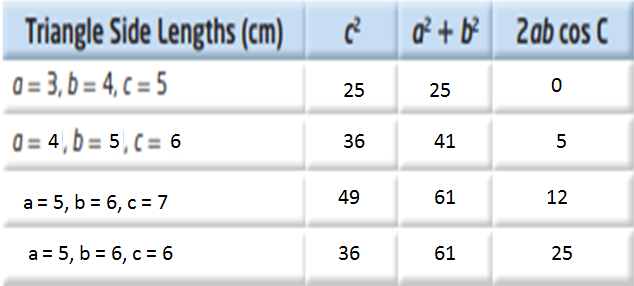
The required completed table is as shown below :-
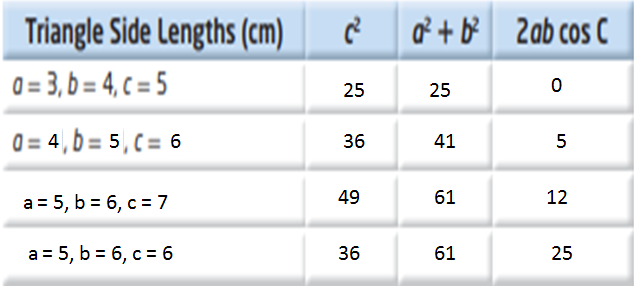
Page 115 Problem 12 Answer
Draw a triangle ABC with angle C obtuse.
Let us draw a triangle with angle C= 94 degrees
The sides are a=3, b=5 and c=6
The equation we got from step 4 is
c2=a2+b2−2abcos(C)
Substitute the values
62=32+52−2(3)(5)cos(94)
36=9+25−(−2)
36=36 True
The equation we got in step 4 hold true for the triangle with angle C= 95, a=3, b=5 and c=6
Page 117 Problem 13 Answer
Given: The distance from point C to A is 35.5 m and from C to B is 48.8 m.
Also, the angle at C is 54∘.
To find: The distance AB.
Use cosine law to find the required distance.
First, draw the diagram for better understanding.
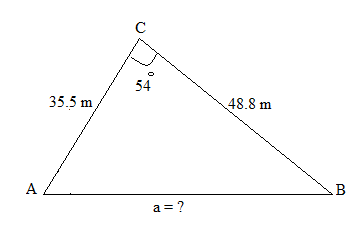
Use cosine law a2=b2+c2−2bccosA to find the distance AB. Herea=AB,b=35.5,c=48.8 and A=54∘.
Substitute all the values in the formula and simplify to find the distance AB.
a2=b2+c2−2bccosA
AB2=35.52+48.82−2(35.5)(48.8)cos54∘
AB2≈1260.25+2381.44−3464.8(0.58778)
AB2≈1260.25+2381.44−2036.5583
AB2≈1605.1316
AB≈√1605.1316
AB≈40.1
Hence the distance AB is approximately 40.1 m.
Mcgraw Hill Precalculus Textbook Answers
Page 119 Problem 14 Answer
Given: In triangle ABC ,a=9,b=7 and ∠C=33.6∘.
To find: The length of the unknown side and the measures of the unknown angles.
Use cosine law to determine the length of the unknown side and the measures of the unknown angles.
First, sketch the diagram of the triangle ABC.
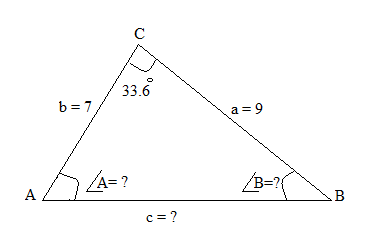
Now find the length of the side c by using cosine law. Substitute a=9,b=7 and ∠C=33.6∘in the cosine law and simplify.
c2=a2+b2−2abcosC
c2=92+72−2(9)(7)cos33.6∘
c2=81+49−126(0.832…)
c2=81+49−104.948…
c2=25.051…
c=√25.051…
c=5
Now find the unknown angles of the triangle.
Substitute a=9,b=7 and c=5 in the cosine law and simplify.
cosB=a2+c2−b2
2ac/cosB=92+52−72/2(9)(5)
cosB=81+25−49/90
cosB=57/90
∠B=cos−1(57/90)
∠B=cos−1/(0.633…)
∠B=50.703∘…
Thus the measure of∠B is approximately 50.7∘.
Use the angle sum property of a triangle to find the measure of angle A
∠A+∠B+∠C=180∘
∠A+50.7∘+33.6∘=180∘
∠A=180∘−(50.7∘+33.6∘)
∠A=180∘−84.3∘
∠A=95.7∘
Thus the measure of∠A is 95.7∘.
Hence the length of side c is 5 and the measures of unknown angles are∠A=95.7∘ and ∠B=50.7∘.
Page 119 Problem 15 Answer
The given figure is:

We need to find the length of the third side of the given triangle.
We will use the Law of Cosine to find the length of the third side of the given triangle.
In the given triangle, we have a=14,b=9 and C=17∘.
Using the Law of Cosine, we get
c2=(14)2+(9)2−2(14)(9)cos(17∘)
c2=196+81−252(0.9563)
c2=277−240.9876
c2=36.0124
c=√36.0124
c≈6
The length of the third side of the given triangle is about 6 cm.
Mcgraw Hill Precalculus Textbook Answers
Page 119 Problem 16 Answer
The given figure is:

We need to find the length of the third side of the given triangle, i.e., MN.
We will use the Law of Cosine to find the length of the third side of the given triangle.
In triangle MNL,NL=13,ML=29 and ∠L=41∘. So, we have a=13,b=29 and C=41∘.
Using the Law of Cosine, we get
c2=(13)2+(29)2−2(13)(29)cos(41∘)
c2=169+841−754(0.7547)
c2=1010−569.0438
c2=440.9562
c=√440.9562
c≈21
The length of the third side of the given triangle is about 21 mm.
Page 119 Problem 17 Answer
The given figure is:

We need to find the length of the third side of the given triangle, i.e., DE.
We will use the Law of Cosine to find the length of the third side of the given triangle.
In the given triangle DEF,EF=21,DF=30,m∠F=123∘..So, we have a=21,b=30 and C=123∘.
Using the Law of Cosine, we get
c2=(21)2+(30)2−2(21)(30)cos(123∘)
c2=441+900−1260(−0.544639)
c2=1341+686.24514
c2=2027.24514
c=√2027.24514
c≈45.02
The length of the third side of the given triangle is about 45.02 m.
Mcgraw Hill Precalculus Textbook Answers
Page 119 Problem 18 Answer
The given figure is:

We need to find the measure of ∠J.
We will use the Law of Cosine to find the measure of the required angle.
In the given triangle the opposite side of angle J is IH=10 m. So, we have a=10,b=11,c=17.
Using the Law of Cosine, we get
cosJ=(11)2+(17)2−(10)2/2(11)(17)
cosJ=121+289−100/374
cosJ=310/374
J=cos−1(310/374)
J≈34.02
The measure of angle J is 34.02∘.
Page 119 Problem 19 Answer
The given figure is:

We need to find the measure of the angle L.
We will use the Law of Cosine to find the measure of the required angle.
In the given triangle the opposite side of angle L is MN=18 cm. So, we have a=18, b=10.4, c=21.9.
Using the Law of Cosine, we get
cosL=(10.4)2+(21.9)2−(18)2/2(10.4)(21.9)
cosL=108.16+479.61−324/455.52
cosL=263.77/455.52
L=cos−1/(263.77/455.52)
L≈54.62∘
The measure of angle L is 54.62∘.
Mcgraw Hill Precalculus Textbook Answers
Page 119 Problem 20 Answer
The given figure is:

We need to find the measure of angle P.
We will use the Law of Cosine to find the measure of the required angle.
In the given triangle the opposite side of angle P is QR=14 mm. So, we have a=14,b=6,c=9.
Using the Law of Cosine, we get
cosP=(6)2+(9)2−(14)2/2(6)(9)
cosP=36+81−196/108
cosP=−79/108
P=cos−1(−79/108)
P≈137.01∘
The measure of angle P is 137.01∘.
Page 119 Problem 21 Answer
The given figure is:

We need to find the measure of angle C.
We will use the Law of Cosine to find the measure of the required angle.
In the given triangle the opposite side of the angle C is AB=31 m. So, we have a=20,b=13,c=31.
Using the Law of Cosine, we get
cosC=(20)2+(13)2−(31)2/2(20)(13)
cosC=400+169−961/520
cosC=−392/520
C=cos−1(−392/520)
C≈138.92∘
The measure of angle C is 138.92∘.
Page 120 Problem 22 Answer
Given: In a triangle PQR,PQ=29,PR=28 and ∠P=52∘.
To find: The length of the unknown side and the measures of the unknown angles.
Use cosine law to determine the length of the unknown side and the measures of the unknown angles.
For finding the unknown side, we will use the cosine law.
Applying cosine law, the length of p will be,
p2=q2+r2−2qrcosP
⇒p2=282+292−2×28×29×cos520
⇒p2=784+841−1624×0.6157
⇒p2=1625−999.8968
⇒p2=625.1032
⇒p=25.00206
Hence, p=25km (approx)
We will find ∠Q by using formula
cosQ=p2+r2−q2/2pr
⇒cosQ=252+292−282/2×25×29
⇒cosQ=625+841−784/1450
⇒cosQ=682/1450
⇒cosQ=0.470345
⇒Q=cos−1/(0.470345)
⇒∠Q=620
Now, ∠R=1800−∠Q−∠P
∠R=1800−620−520
∠R=660
Hence, The missing angles are 620 and 520
The missing angles are 620 and 520.
The missing side is 25km
Page 120 Problem 23 Answer
Given that : In ΔRST,
Sidesr=5cm,s=9.1cm,t=6.8cm
To Find :∠R,∠S,∠T
Strategy: We will use cosine law to find the angles of triangle.
or ∠R, we have
cosR=s2+t2−r2/2st
⇒cosR=9.12+6.82−52/2×9.1×6.8
⇒cosR=82.81+46.24−25/123.76
⇒cosR=104.05/123.76
⇒cosR=0.84074
⇒R=cos−1/(0.84074)
⇒R=32.78 (approx) Using cosine inverse table
⇒∠R=330
For ∠S, we have
cosS=r2+t2−s2/2rt
⇒cosS=52+6.82−9.12/2×5×6.8
⇒cosS=25+46.24−82.81/2×5×6.8
⇒cosS=−11.57/68
⇒cosS=−0.17015
⇒S=cos−1(−0.170150)
⇒S=99.796 (approx) using cosine inverse table
Hence, ∠S=1000
We will use the following relation to find ∠T:∠R+∠S+∠T=1800
⇒330+1000+∠T=1800
⇒1330+∠T=1800
⇒∠T=1800−1330
⇒∠T=470
Hence, ∠T=470
he measure of angles of ΔRST is∠R=330,∠S=1000,∠T=470.
Page 120 Problem 24 Answer
Given: In a triangle ABC, AB=24, AC=34 and ∠A=67∘.
To find: The length of BC.
Use cosine law to determine the required length.
First sketch the triangle ABC.
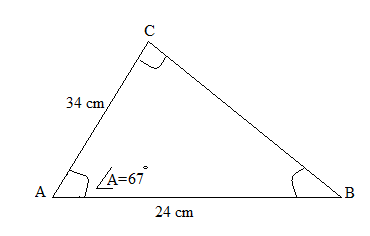
SubstituteAB=24, AC=34 and ∠A=67∘in the cosine law and simplify.
BC2=AB2+AC2−2(AB)(AC)cosA
BC2=242+342−2(24)(34)cos67∘
BC2=576+1156−1632(0.390…)
BC2=576+1156−637.673…
BC2=1094.326…
BC=√1094.326…
BC=33
Hence the length of BC is approximately33 m.
Page 120 Problem 25 Answer
Given: In a triangle ABC, AB=15,BC=8 and ∠B=24∘.
To find: The length ofAC.
Use cosine law to determine the required length.
First sketch the triangle ABC.
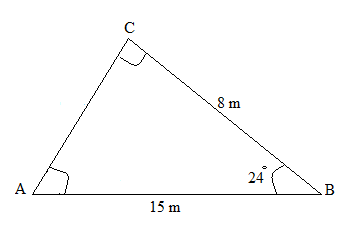
SubstituteAB=15,BC=8 and ∠B=24∘in the cosine law and simplify to find the length of AC.
AC2=AB2+BC2−2(AB)(BC)cosB
AC2=152+82−2(15)(8)cos24∘
AC2=225+64−240(0.913…)
AC2=225+64−219.250…
AC2=69.749…
AC=√69.749…
AC=8.4
Hence the length of AC is approximately 8.4 m.
Page 120 Problem 26 Answer
Given: AC = 10 cm, BC = 9 cm, and ∠C = 48°. To Determine the length of AB.By using cosine law
We have triangle ABC with AC = 10 cm, BC = 9 cm, and ∠C = 48°
So according to the cosine law

AB2=102+92−2(10)(9)cos48∘
AB2=60.556…
AB2=√60.556…
AB=7.781…
AB=7.8 cm , to the nearest tenth of a centimetre
Hence, the length of AB. is 7.8 cm
Page 120 Problem 27 Answer
Given: AB = 9 m, AC = 12 m, and BC = 15 m.To Determine the measure of ∠B.By using sine ratio
We have AB = 9 m, AC = 12 m, and BC = 15 m.
△ABC is a right triangle, because 152=92+122

Use the sine ratio.
sin ∠B∠B
=12/15
=sin−1(12/15)
=53.130…
R=53∘
∠B=53∘, to the nearest degree.
Hence, the measure of ∠B is 53o
Page 120 Problem 28 Answer
Given: AB = 18.4 m, BC = 9.6 m, and AC = 10.8 m. To Determine the measure of ∠A.By using cosine law
We have AB = 18.4 m, BC = 9.6 m, and AC = 10.8 m.
using the cosine law

9.62=10.82+18.42−2(10.8)(18.4)cosA
92.19=116.64+338.56−397.44cosA
397.44cosA=455.2−92.19
cosA=363.01/397.44
∠A=cos−1(363.01/397.44)
∠A=24.024…
∠A=24∘, to the nearest degree.
Hence, the measure of ∠A is 24o
Page 120 Problem 29 Answer
Given: AB = 4.6 m, BC = 3.2 m, and AC = 2.5 m. Determine the measure of ∠C.
To Determine the measure of ∠C.By using cosine law
We have AB = 4.6 m, BC = 3.2 m, and AC = 2.5 m.
Using cosine law
4.62=3.22+2.52−2(3.2)(2.5)cosC
21.16=10.24+6.25−16cosC
16cosC=16.49−21.16
cosC=−4.67/16
∠C=cos−1(−4.67/16)
∠C=106.970…
∠C=107∘, to the nearest degree.
Hence, measure of ∠C is ∠C=107,

